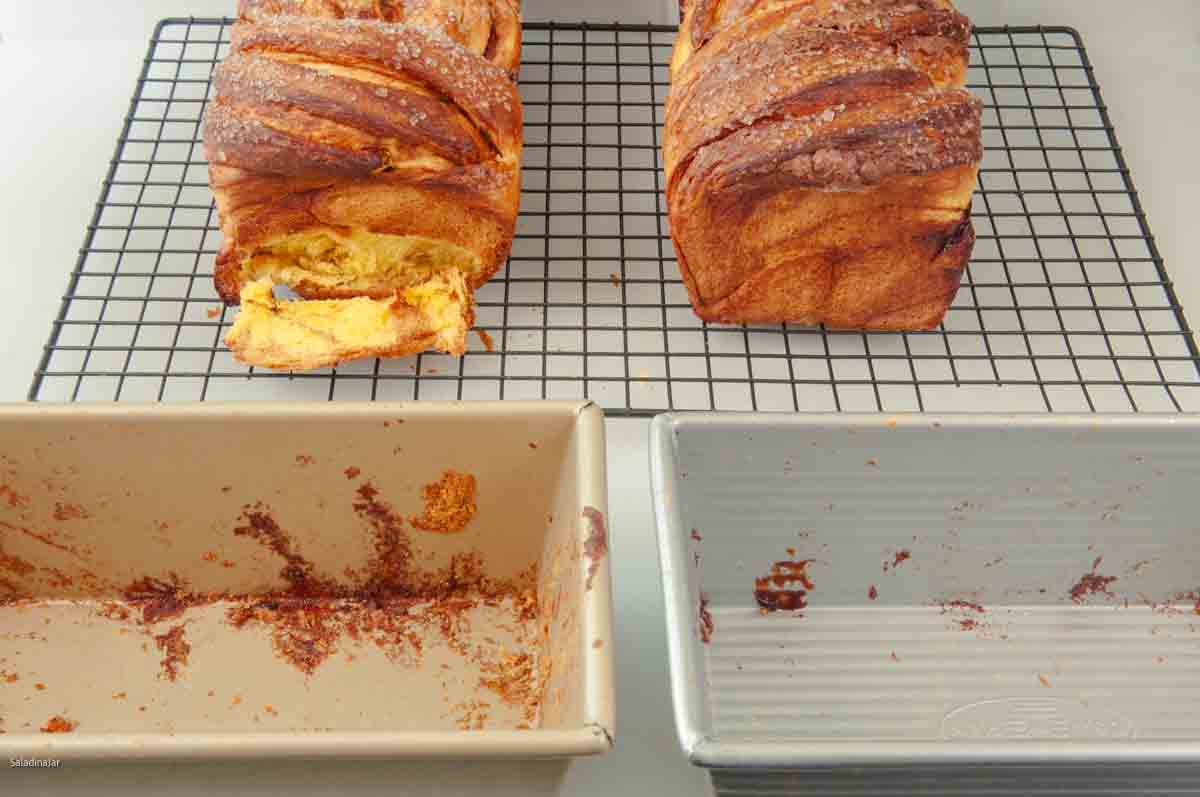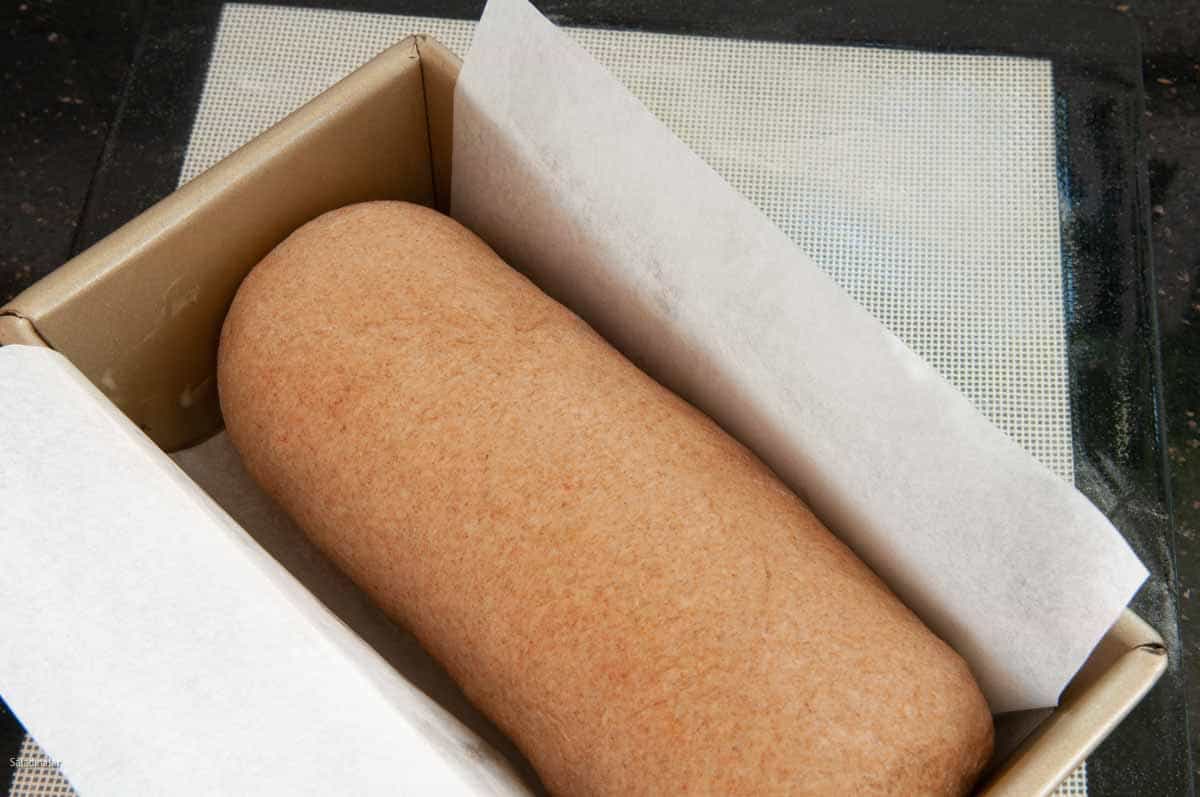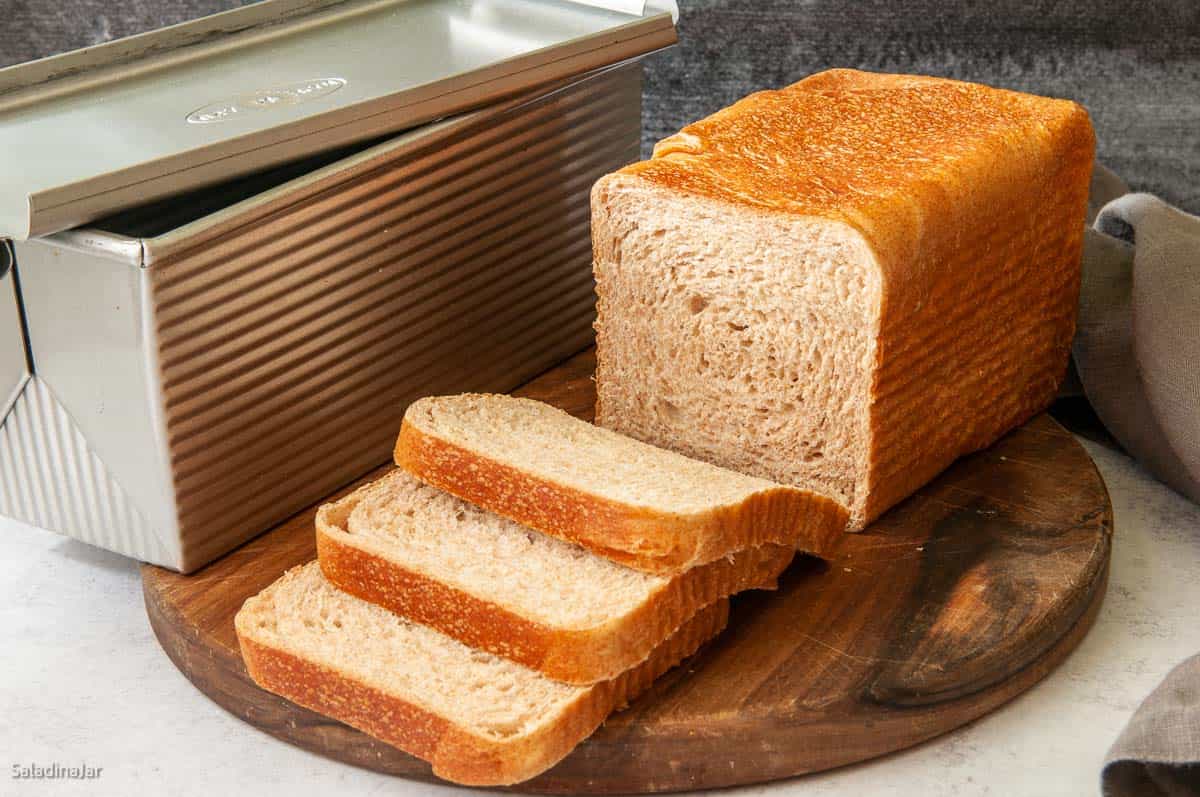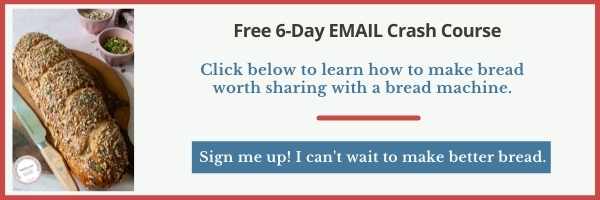10 Pro Tips To Ensure Your Bread Slides Out of the Pan Easily
Sneak Preview: Read my 10 expert tricks for flawless, non-stick bread release – whether from a traditional pan or a bread machine. Learn how to modify your current bread pan to make it more non-stick, or else buy a high-quality pan. Say goodbye to sticky mishaps!

As an Amazon Associate, I earn from qualifying purchases.
Have you ever struggled to remove a fresh loaf of bread from the pan without tearing it? It’s disheartening, especially after the effort put into baking, and even more so if you planned to share it. 😩
10 Tips To Prevent the Stick

- Grease the Pan: Always grease your bread pan well (unless the manufacturer recommends against it). You can use butter, oil, or non-stick cooking spray. Make sure to get into the corners and up the sides.
- Use Parchment Paper: Line the bottom and sides of your pan with parchment paper (paid link), leaving an overhang (make a sling) to make it easy to lift the bread out of the pan.
- Check for Scratches: Non-stick pans can get scratched over time, which makes them more prone to sticking. If your pan is scratched or worn out, consider replacing it.
- Avoid Sharp Knives: With tip #3 in mind, use a thin plastic spatula, butter knife, or my favorite–a plastic spreader (paid link) to loosen the loaf from the pan.
- Don’t Overproof: Overproofed bread can sometimes become stickier and more likely to adhere to the pan.
- Shape Dough Properly: Creating surface tension by shaping the dough reduces sticking as opposed to stuffing dough into the pan, which is one reason why loaves baked in a bread machine often stick.
- Be Careful about Glazes: If they drip down the side of the bread, they can glue the bread to the pan.
- Let the Bread Cool: Cooling your bread for 10-15 minutes after baking can serve two purposes:
- The bread will begin to pull away from the sides, making it easier to remove.
- The short cool-down helps to stabilize the sides of soft bread so it won’t collapse.
- Quality Matters: Invest in good-quality, heavy-duty pans. They distribute heat more evenly and tend to have better non-stick qualities. Read more about my favorite brand below.
- Use Seamless Pans: They are easier to clean thoroughly because there are no seams for crumb particles to hide in (which can cause sticking). Here is a good example of a seamless pan that was recommended by one of my readers.
If you are in the market for a bread pan, let’s talk materials.
What Material Is Best for a Bread Pan?
I’m sharing the experience I’ve learned from baking bread for most of my life. I’ve tried cheap pans, foil pans, black pans, dull aluminum pans, glass dishes, cast iron skillets, shiny pans, metal jello molds, and, of course, bread machine pans.
- Glass dishes: The corners tend to overcook. Reduce the temperature by 25˚F.
- Black pans: The crust color will be dark, and the bread tends to stick, especially if the pan is thin (cheap). Reduce the temperature by 25˚F–this rule also applies to heavy bundt pans with a black coating on the interior.
- Dull aluminum pans: I have inherited a few of these pans. They are heavy enough to brown my bread satisfactorily, but they are not non-stick without intervention. The metal jello mold I got from my mother fits into this category.
- Cast iron skillets: Like black pans, these will make a dark, sometimes thick, crust. Use plenty of oil to make them stick less. These require regular maintenance to keep them from rusting.
- Disposable foil pans: These pans tend to brown inconsistently. For even browning and easier handling, place them onto a heavy cookie sheet during baking.
- Shiny aluminum pans: Nothing beats a heavy, shiny, aluminized steel bread pan with a built-in nonstick finish. This describes my favorite USA pans. Read more about them below.

My Favorite Bread Pan
Disclaimer: I have purchased and used all of the pans listed below. None were given to me for free. My recommendations are based on lifelong experience with baking bread. Please note that any purchases made through Amazon may earn me a small commission at no extra cost to you.
The USA Pan is unparalleled in my experience. Homemade loaves easily release without the aid of parchment, oil, or sprays. Usually, there’s no need for a spatula or knife. Notably, the manufacturer suggests avoiding the use of non-stick sprays and washing in the dishwasher. Both things can ruin the non-stick finish.
Where to find these pans? I’ve seen them in fine kitchen stores, Costco (limited selection), the USA Pan website, and Amazon.
If you use my recipes, I recommend you collect these pans to use anytime you bake bread in your oven:
- 8½ x 4½-inch loaf pan (1 pound)
- 9 x 5-inch loaf pan (1¼-1½ pound loaf)
- 9 x 4 x 4 inch Pullman pan (can take the place of #1 and #2) (seen in the picture above)
- A set of 4 mini-loaf pans if you like to share your bread with others
- 8-inch round cake pans (good for dinner rolls or cinnamon rolls)
- Half-sheet baking or cookie pans
Do you bake bread in a bread machine occasionally or all the time? Here are seven tips specifically for you.
How Can I Prevent Bread from Sticking in a Bread Machine Pan?
Getting baked bread out of a bread machine without causing damage or having it stick can sometimes be a challenge. Here are eight tips to try:
- Grease the Pan: Before adding ingredients, lightly coat the bread pan with non-stick spray, butter, or oil. This creates a barrier between the bread and the pan, making it easier to release.
- Patience: After the baking cycle is complete, don’t rush to get the bread out. Let it sit for about 10-15 minutes. As the bread cools, it contracts slightly, which can help ease it out.
- Gentle Shakes: Hold the pan with oven mitts and gently shake it side to side. This can help loosen the bread from the sides.
- Clean the Inside of the Paddles: Small pieces of dough can get inside the blades and glue them to the post as the bread bakes. This can make the bread almost impossible to remove, not to mention the paddles. If you can’t get the paddles out, soak them in water for hours or try wiggling them from the top with one hand while you hold the base on the outside and bottom of the bread machine pan. Use a rubber glove or rubber jar gripper to hang on to it.
- Use a Plastic or Silicone Spatula: Run a plastic spatula or spreader(paid link) around the edges of the pan to release the bread. Avoid using metal utensils as they can scratch and damage the non-stick coating of the bread pan.
- Care for Your Pan: Over time, the non-stick coating can wear off. Avoid using abrasive cleaners or scouring pads. Hand wash with soft sponges and mild detergent. Consider replacing the pan if the non-stick coating deteriorates–same with the kneading paddle(s). If you find a bread machine like yours in a garage sale or thrift store, it might be worth the price to use it for spare parts.
- Check Dough Consistency: If the dough is too wet, it might stick more. Ensure you measure accurately and adjust the liquid content if necessary.
- Don’t bake bread in the bread machine, and you’ll never have trouble getting it out of the pan.😉 (You knew I would say that if you’ve ever used one of my bread recipes.) But that’s not helpful if you like to use the bread machine for every step.
Parting thoughts: I hope one of these tips gave you an idea. Do you have a tip for getting your bread out of a pan without injury? Please leave it in the comments.
Help at Your Fingertips: For questions or suggestions, email Paula at saladinajar.com. If you need help, I’m happy to troubleshoot via email (faster than leaving a comment). Attach pictures and as many details as possible for the best advice.


Paula Rhodes, owner
As a retired home economist, I created Saladinajar.com to share my belief that you don’t have to be a chef to find joy in creating homemade food worth sharing. Bread machines (used in an unconventional way), homemade yogurt, and quick microwave recipes are my specialty.